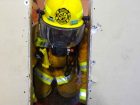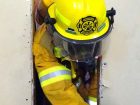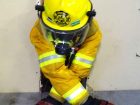
Features
Structural
Training
Trainer’s Corner: September 2016
At the 2016 British Columbia annual volunteer firefighter training seminar, hosted this year by Osoyoos Fire Department, I witnessed far too many firefighters struggle with their SCBA packs while trying to manoeuvre through tight and narrow openings. Some firefighters spent valuable airtime going low profile, while others took their BA packs right off. Both these methods of manoeuvring through wall breaches or narrow openings have been taught to firefighters for decades and for the most part they are safe and will work. However, there is a third method that our SOO HOT (Saving Our Own Hands-On Training) crew uses that is just too good to not share – we call it the cross-under technique.
August 29, 2016
By
Ed Brouwer
Firefighters going low profile, or removing their BAs to push them through narrow openings, takes precious time and it takes even more time to re-don the BAs.
Some fire instructors teach that re-tightening the straps in a survival situation is not that important due to the fact firefighters want to exit the structure as fast as they can. I totally disagree. Firefighters who do not tighten their BAs, which takes seconds, risk becoming entangled, which could result in minutes spent trying to get free. Minutes during a fire could mean the difference between life and death . . . so tighten your straps!
Not only is entanglement a concern, a loose tank flopping around on a member’s back can push up against the helmet, which in turn can jar the mask. And that may be the last thing a firefighter remembers in an IDLH (immediate danger to life and health) environment.
Note: It is always risky to remove the SCBA completely to pass it through a tight, narrow opening. Any time firefighters partially or totally remove their SCBAs within an IDLH atmosphere, they increase both the risk of exposure to deadly fire products and the chance of something going wrong with the SCBA. And if members fail to properly re-don their SCBAs while in an IDLH environment, a number of critical safety issues can develop. Bunched up bunker gear and loose straps can all impede survival and rescue.
There is a commercial on TV that advertises a chair lift for seniors having trouble using stairs. A line in the commercial that always gets me is, “We have the solution, just don’t fall.” Now I find myself saying to you: if firefighters are getting into trouble doffing and re-donning their SCBAs in IDLH atmospheres, we have the solution, just don’t doff!
Our SOO HOT crew recommends and practices a simple cross-under method to manoeuvre through narrow openings. We very seldom, if ever, remove or low profile our BAs.
The cross-under method we have perfected is very simple and once you practise it, I am sure you will agree. We simply stay on our hands and knees; this is the key.
Before entering into a wall breach or manoeuvring through a tight or narrow opening, be sure to sound the floor, look up, look left and right. In other words, be sure you really want to proceed. In some cases it may be better to wait for the rapid intervention team (RIT) to find you. The following steps assume you have determined it is safe to proceed.
Do not adjust your BA. Get into a crawling position (hands and knees). Stay on your hands and knees throughout the entire manoeuvre. For our practice sessions we use a prop simulating a wall breach opening between 2×4 studs at 16-inch centres. Crawl up to the opening and place your shoulders squarely against the two studs. Now reach your left hand through the hole, placing your hand flat on the floor to the right of the hole. As you drop your hand, your left shoulder will drop and easily slip through the hole. Then take your right hand and go under your left arm, placing your right hand flat on the floor to the left of the hole; your right shoulder will drop and slip through the opening.
Now, if you positioned yourself correctly, your upper body is through the hole and you are still on your hands and knees. Your BA tank is square on your back and already halfway through the opening. Now slowly crawl forward and as your hip touches the side of the hole (left or right, depending on which knee you moved first) drop that hip (under your belly button) but stay on your hands and knees. Your dropped hip should slip through the hole. Now do that with the opposite hip as you crawl forward. That is it – you are through that narrow opening without the risks involved with going low profile or complete BA removal. This takes no time at all and it saves your air, your energy and maybe even your life.
No doffing, no re-donning, no face-mask jarring, no real effort and above all no time loss. It doesn’t get any better in an IDLH atmosphere with just minutes of air left in your tank.
Please note that when we practise this technique we insist that firefighters inform the incident commander of their objectives and progress. We also implement mayday protocols and RIT response. Use full personal protective equipment (PPE) and use gloves even for radio communications. Practise the way you would respond in the real world.
The cross-under manoeuvre can be another tool in the tool box of firefighter safety. Build a prop and have fun learning the technique. Stay safe and remember: train as though their lives depend on it!
Ed Brouwer is the chief instructor for Canwest Fire in Osoyoos, B.C., and training officer for Greenwood Fire and Rescue. He is also a fire warden with the B.C. Ministry of Forests, a wildland urban interface fire-suppression instructor/evaluator and an ordained disaster-response chaplain. Ed has written Trainer’s Corner for 15 of his 27 years in the fire service. Contact Ed at ebrouwer@canwestfire.org
Print this page


